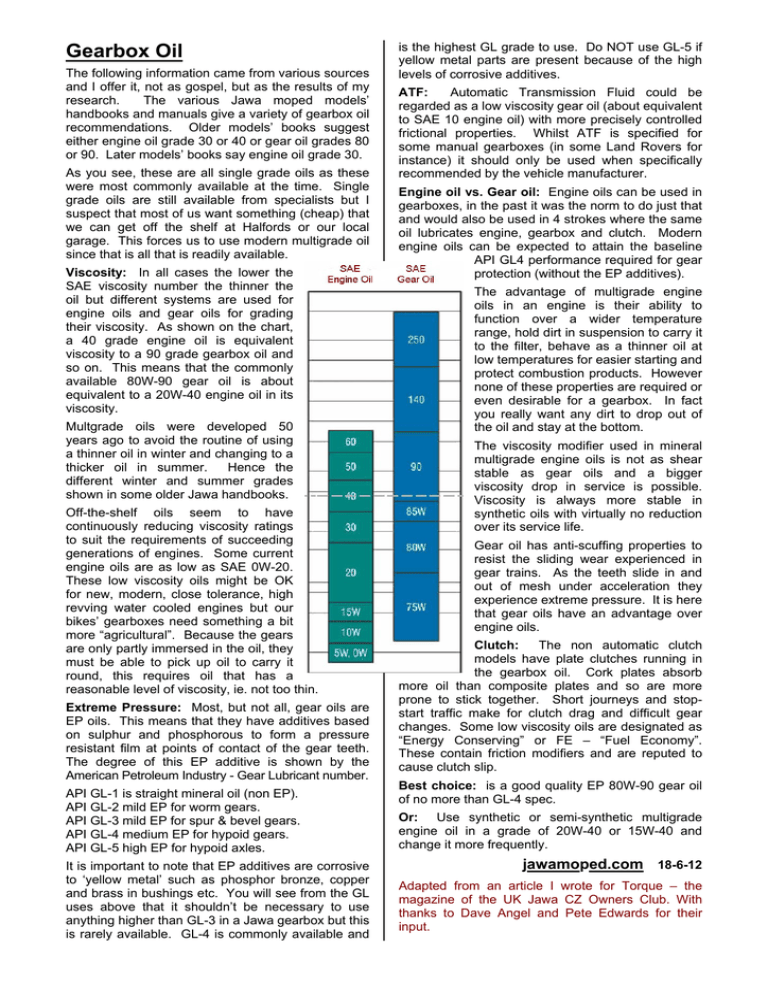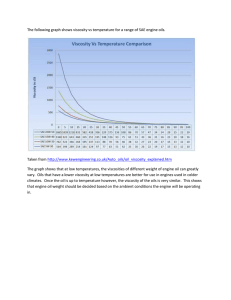Gearbox Oil - jawa moped
advertisement

Gearbox Oil The following information came from various sources and I offer it, not as gospel, but as the results of my research. The various Jawa moped models’ handbooks and manuals give a variety of gearbox oil recommendations. Older models’ books suggest either engine oil grade 30 or 40 or gear oil grades 80 or 90. Later models’ books say engine oil grade 30. As you see, these are all single grade oils as these were most commonly available at the time. Single grade oils are still available from specialists but I suspect that most of us want something (cheap) that we can get off the shelf at Halfords or our local garage. This forces us to use modern multigrade oil since that is all that is readily available. Viscosity: In all cases the lower the SAE viscosity number the thinner the oil but different systems are used for engine oils and gear oils for grading their viscosity. As shown on the chart, a 40 grade engine oil is equivalent viscosity to a 90 grade gearbox oil and so on. This means that the commonly available 80W-90 gear oil is about equivalent to a 20W-40 engine oil in its viscosity. Multgrade oils were developed 50 years ago to avoid the routine of using a thinner oil in winter and changing to a thicker oil in summer. Hence the different winter and summer grades shown in some older Jawa handbooks. Off-the-shelf oils seem to have continuously reducing viscosity ratings to suit the requirements of succeeding generations of engines. Some current engine oils are as low as SAE 0W-20. These low viscosity oils might be OK for new, modern, close tolerance, high revving water cooled engines but our bikes’ gearboxes need something a bit more “agricultural”. Because the gears are only partly immersed in the oil, they must be able to pick up oil to carry it round, this requires oil that has a reasonable level of viscosity, ie. not too thin. Extreme Pressure: Most, but not all, gear oils are EP oils. This means that they have additives based on sulphur and phosphorous to form a pressure resistant film at points of contact of the gear teeth. The degree of this EP additive is shown by the American Petroleum Industry - Gear Lubricant number. API GL-1 is straight mineral oil (non EP). API GL-2 mild EP for worm gears. API GL-3 mild EP for spur & bevel gears. API GL-4 medium EP for hypoid gears. API GL-5 high EP for hypoid axles. It is important to note that EP additives are corrosive to ‘yellow metal’ such as phosphor bronze, copper and brass in bushings etc. You will see from the GL uses above that it shouldn’t be necessary to use anything higher than GL-3 in a Jawa gearbox but this is rarely available. GL-4 is commonly available and is the highest GL grade to use. Do NOT use GL-5 if yellow metal parts are present because of the high levels of corrosive additives. ATF: Automatic Transmission Fluid could be regarded as a low viscosity gear oil (about equivalent to SAE 10 engine oil) with more precisely controlled frictional properties. Whilst ATF is specified for some manual gearboxes (in some Land Rovers for instance) it should only be used when specifically recommended by the vehicle manufacturer. Engine oil vs. Gear oil: Engine oils can be used in gearboxes, in the past it was the norm to do just that and would also be used in 4 strokes where the same oil lubricates engine, gearbox and clutch. Modern engine oils can be expected to attain the baseline API GL4 performance required for gear protection (without the EP additives). The advantage of multigrade engine oils in an engine is their ability to function over a wider temperature range, hold dirt in suspension to carry it to the filter, behave as a thinner oil at low temperatures for easier starting and protect combustion products. However none of these properties are required or even desirable for a gearbox. In fact you really want any dirt to drop out of the oil and stay at the bottom. The viscosity modifier used in mineral multigrade engine oils is not as shear stable as gear oils and a bigger viscosity drop in service is possible. Viscosity is always more stable in synthetic oils with virtually no reduction over its service life. Gear oil has anti-scuffing properties to resist the sliding wear experienced in gear trains. As the teeth slide in and out of mesh under acceleration they experience extreme pressure. It is here that gear oils have an advantage over engine oils. Clutch: The non automatic clutch models have plate clutches running in the gearbox oil. Cork plates absorb more oil than composite plates and so are more prone to stick together. Short journeys and stopstart traffic make for clutch drag and difficult gear changes. Some low viscosity oils are designated as “Energy Conserving” or FE – “Fuel Economy”. These contain friction modifiers and are reputed to cause clutch slip. Best choice: is a good quality EP 80W-90 gear oil of no more than GL-4 spec. Or: Use synthetic or semi-synthetic multigrade engine oil in a grade of 20W-40 or 15W-40 and change it more frequently. jawamoped.com 18-6-12 Adapted from an article I wrote for Torque – the magazine of the UK Jawa CZ Owners Club. With thanks to Dave Angel and Pete Edwards for their input.


